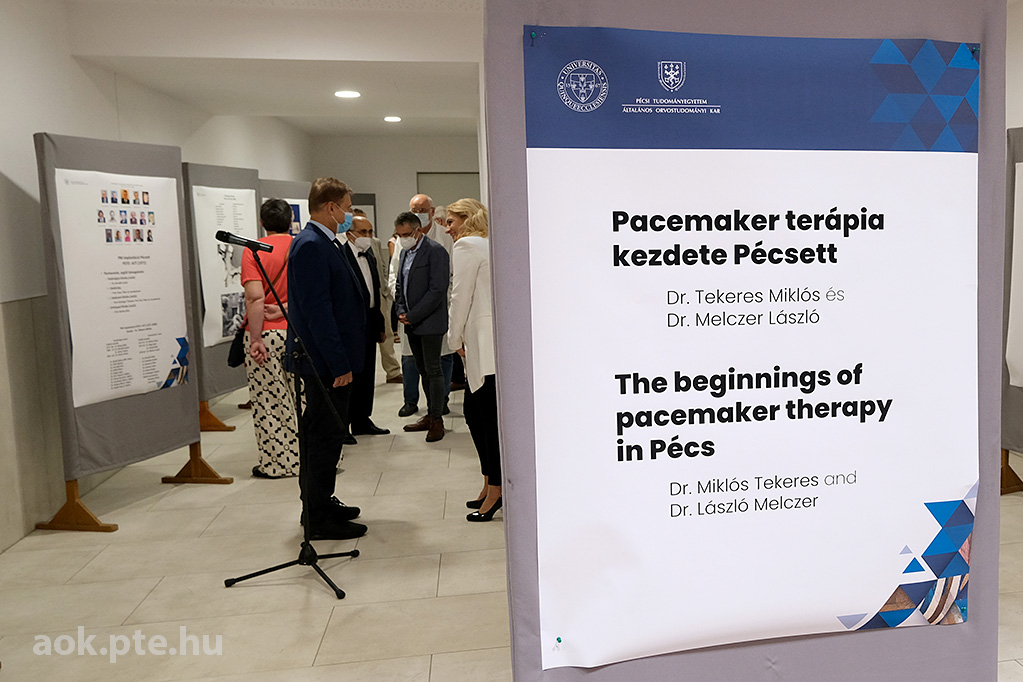The first thirty years of pacemaker therapy in Pécs, the period from 1971 to 2001, are presented in the exhibition on the first-floor gallery of the theoretical building of our School. The exhibition opened on 13 September and can be visited until 31 December. Most of the material in the collection was collected by dr. László Melczer, associate professor at the Heart Institute, holder of a candidate degree, who has been implanting, programming the devices, and monitoring patients for 45 years. The presentation of these lifesaving technologies that improve the quality of life can be important and interesting not only for professionals, but also for those who are interested in the historical development of medical instruments and devices.
Written by Rita Schweier
 - Who contributed to the fact that this wide range of devices can be presented?
- Who contributed to the fact that this wide range of devices can be presented?
- We are grateful to Professor Miklós Tekeres, who is one of the first domestic users of pacemaker therapy, for the first pieces of the collection. Pacemaker therapy began in 1971 at the Central Department of Anaesthesiology and Intensive Care where the first transvenous pacemaker was implanted. It had been the predecessor of the Department of Anaesthesiology and Intensive Therapy, of which the professor was the head of department. I have collected the other devices myself over the decades. In 1976, I started working at the Central Department of Anaesthesiology and Intensive Care at POTE, where I joined the pacemaker therapy group. I performed the first pacemaker surgery with the assistance of Dr. Miklós Tekeres in 1978, and on my own later on, and from there onwards I tried to enrich the collection knowingly.
- How many devices of how many manufacturers are displayed?
- 29 pacemakers from ten manufacturers with their own programming devices. The programming devices can be presented in part with photos because they are large due to the technology of the time, but some devices can be viewed in the showcases.
- What was the very first device like, and how did we get to today's modern pacemakers?
- The first device in the world was implanted as a life-saving procedure during cardiac surgery in 1958, where it was placed in the abdominal wall. Five years later, pacemaker therapy began in Hungary with a life-saving surgery, and the same thing happened in Pécs eight years later. The first devices were large, powered by mercury batteries, which had a very short lifespan - 1.5-2.5 years - compared to today. Due to development, the latter can function up to 12-15 years. Besides the titanium case, electronics has evolved the most and the unified system of electrode connectors that we use today has been established.
- How has the therapy changed because of the modernization and refinement of the devices?
- In the early period, implanting a device had been a life-saving intervention, but development required the creation of different types of pacemakers that have also become suitable for a variety of treatments for cardiac arrhythmia and conduction disorders. This brought with it the possibility of elective pacemaker implantations. In the early 1990s, a team was formed within POTE AITI, which enabled the introduction of new types of pacemakers in clinical practice, the development of a modern pacemaker outpatient clinic, thus the realization of complex patient care, and it also resulted in a high level of scientific activity.
Dr. Csaba Melczer, the son of dr. László Melczer also participated in the organization of the exhibition. They considered it important to thank their former colleagues, the current management of the Heart Institute and the staff of the Dean’s Office for their creative cooperation.

